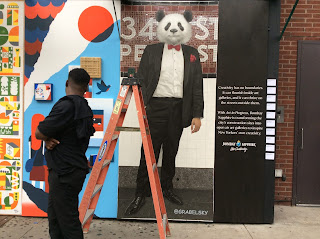1. Skyrocketing rents and non-renewal of leases on mom-and-pop shops created the luxury chain takeover, starting in 2001 with Marc Jacobs. Those blocks went from quaint and local to high-end suburban mall in just five years.
2. It took another five to die, as those big chains departed, emptying the storefronts and leaving the street in a state of high-rent blight.
3. Recently we heard that mega-developer Brookfield Properties would take over, spending approximately $31.5 million for several retail condos to convert them into a concept, a curated consumer experience, “with Brookfield orchestrating…rather than allowing each individual shop to pursue its own agenda,” reported New York magazine. “Let’s look at this as if it’s a mall,” said Brookfield’s head of retail leasing, “even though it’s not.”
Now we know what that looks like.

WWD reports on the program to curate the street. It's called "Love, Bleecker" and it has a creative director, fashion designer Prabal Gurung. There will be a leather "concept store" called Slightly Alabama, a florist/plant-based food shop, and a gallery space with prisms, among other "disruptive" and "innovative" and "creative" businesses.
Writes WWD, "Brookfield considers Bleecker to be a new kind of retail activation and platform for growing online digital native brands that may eventually populate its other properties." (And here I thought it was a neighborhood.) "We'll incubate them here and see them thrive and grow," says Sara Fay, VP of Marketing at Brookfield.
Brookfield, according to WWD, "plumbed Bleecker Street's history as a magnet for jazz and folk music and stomping ground for Beat poets such as Allen Ginsberg and Jack Kerouac."
Incubation, artwashing, and the co-opting of the neighborhood's counter-cultural history? Sounds like more invasion of the body snatchers.
The project kicked off yesterday. Do not miss the website.


















